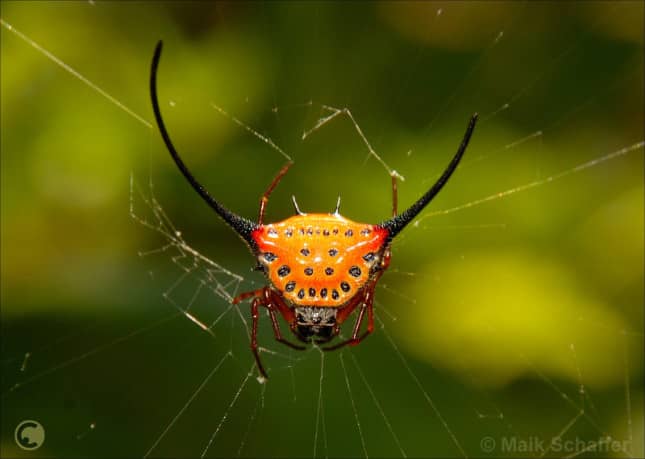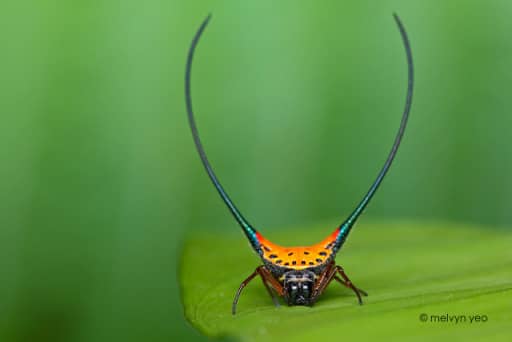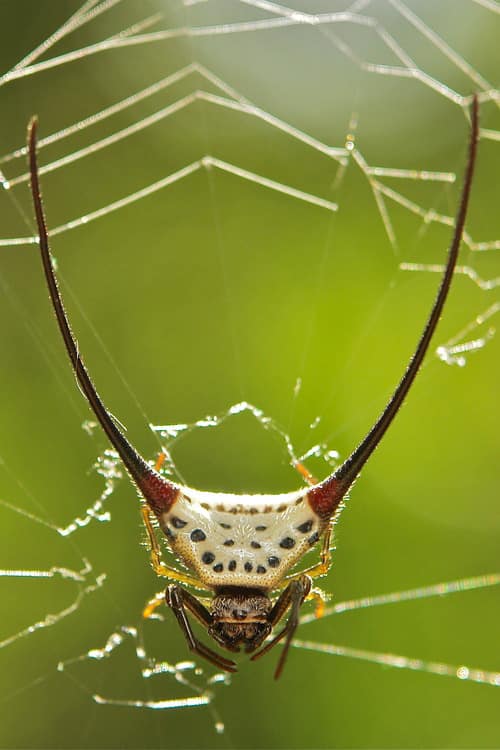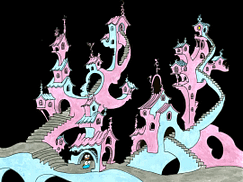Long-Horned Orb-Weaver Spider
Familia: Araneidae
Subfamilia: Gasteracanthinae
Genus: Macracantha
Species: Macracantha arcuata
Long-horned orb-weaver spider lives predominantly in primary forest. As members of the orb-weaver family of spiders, these amazing creatures build the typical circular web of their cousins across pathways so you can walk into them in the dark. The purpose of the disproportionately long body horns however remains a mystery.
Generally, orb-weaving spiders are three-clawed builders of flat webs with sticky spiral capture silk. The building of a web is an engineering feat, begun when the spider floats a line on the wind to another surface. The spider secures the line and then drops another line from the center, making a “Y”. The rest of the scaffolding follows with many radii of nonsticky silk being constructed before a final spiral of sticky capture silk.
The third claw is used to walk on the nonsticky part of the web. Characteristically, the prey insect that blunders into the sticky lines is stunned by a quick bite, and then wrapped in silk. If the prey is a venomous insect, such as a wasp, wrapping may precede biting and/or stinging.
Many orb-weavers build a new web each day. Most orb-weavers tend to be active during the evening hours; they hide for most of the day. Generally, towards evening, the spider will consume the old web, rest for approximately an hour, then spin a new web in the same general location. Thus, the webs of orb-weavers are generally free of the accumulation of detritus common to other species, such as black widow spiders.
Some orb-weavers do not build webs at all. Members of the genera Mastophora in the Americas, Cladomelea in Africa, and Ordgarius in Australia produce sticky globules, which contain a pheromone analog. The globule is hung from a silken thread dangled by the spider from its front legs. The pheromone analog attracts male moths of only a few species. These get stuck on the globule and are reeled in to be eaten. Interestingly, both types of bolas spiders are highly camouflaged and difficult to locate.
The spiny orb-weaving spiders in the genera Gasteracantha and Micrathena look like plant seeds or thorns hanging in their orb-webs. Some species of Gasteracantha have very long, horn-like spines protruding from their abdomens.
One feature of the webs of some orb-weavers is the stabilimentum, a crisscross band of silk through the center of the web. It is found in a number of genera, but Argiope, the yellow and banded garden spiders of North America, is a prime example. The band has been hypothesized to be a lure for prey, a marker to warn birds away from the web, and a camouflage for the spider when it sits in the center of the web. However, recent research suggests the stabilimentum actually decreases the visibility of the silk to insects, thus making it harder for prey to avoid the web. The orb-web consists of a frame and supporting radii overlaid with a sticky capture spiral, and the silks used by orb-weaver spiders have exceptional mechanical properties to withstand the impact of flying prey.
During the Cretaceous, a radiation of angiosperm plants and their insect pollinators occurred. Fossil evidence shows that the orb web was in existence at this time, which permitted a concurrent radiation of the spider predators along with their insect prey. The capacity of orb–webs to absorb the impact of flying prey led orbicularian spiders to become the dominant predators of aerial insects in many ecosystems. Insects and spiders have comparable rates of diversification, suggesting they co-radiated, and the peak of this radiation occurred 100 Mya before the origin of angiosperms. Vollrath and Selden (2007) make the bold proposition that insect evolution was driven less by flowering plants than by spider predation – particularly through orb webs – as a major selective force.
Most arachnid webs are vertical and the spiders usually hang with their head downward. A few webs, such as those of orb-weavers in the genus Metepeira have the orb hidden within a tangled space of web. Some Metepiera are semisocial and live in communal webs. In Mexico, such communal webs have been cut out of trees or bushes and used for living fly paper. In 2009, workers at a Baltimore Wastewater Treatment Plant called for help to deal with over 100 million orb-weaver spiders, living in a community that managed to spin a phenomenal web that covered some 4 acres of a building with spider densities in some areas reaching 35,176 spiders per cubic meter.









